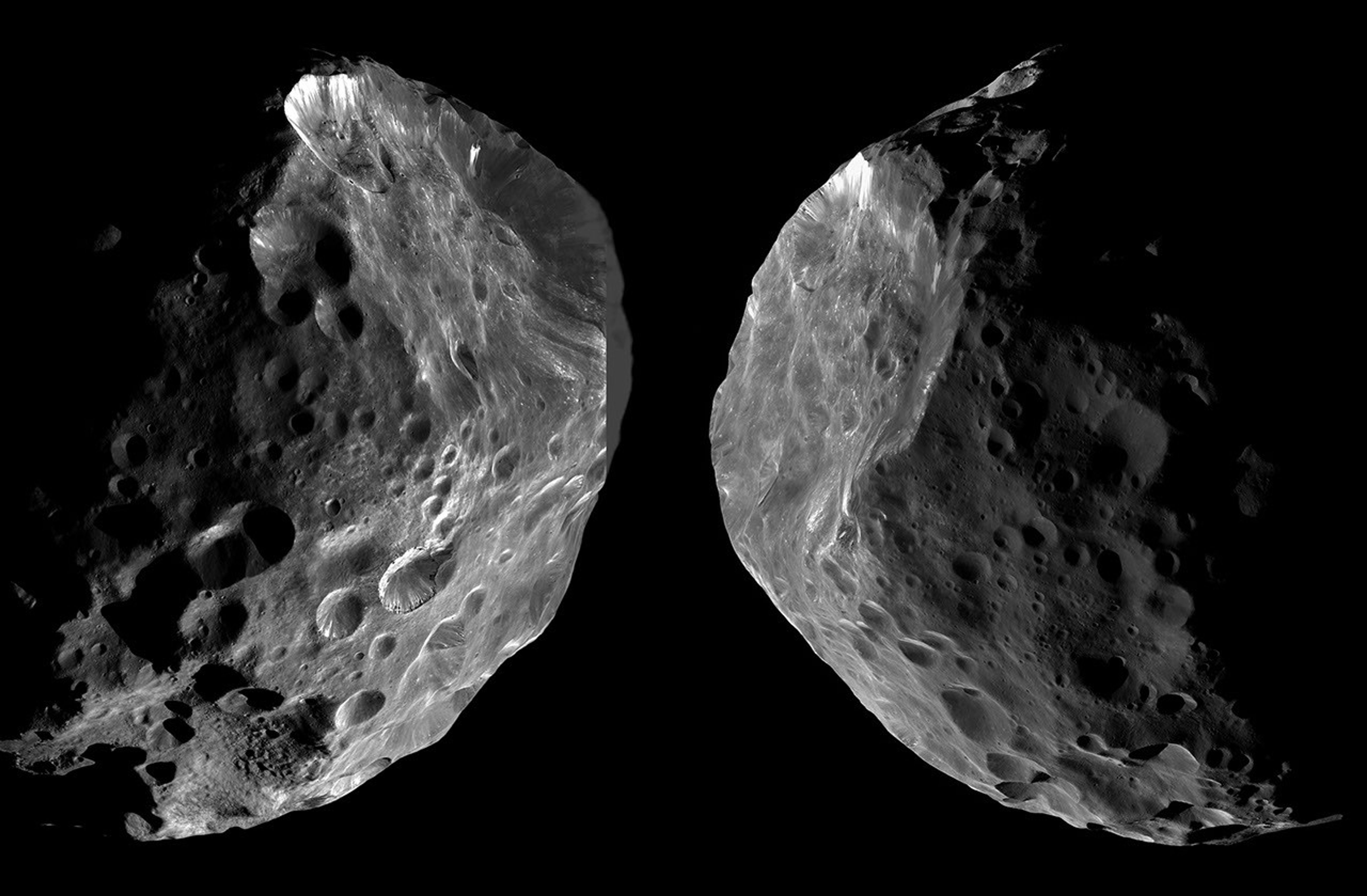Arrival and Departure at Phoebe
| PIA Number | PIA18411 |
|---|---|
| Language |
|
As it entered the Saturn system, NASA's Cassini spacecraft performed its first targeted flyby of one of the planet's moons. On June 11, 2004, Cassini passed Phoebe, the largest of Saturn's outer or "irregular" moons, at an altitude of just 1,285 miles (2,068 kilometers). This was the sole close flyby of one of the outer moons of Saturn in the entire Cassini mission.
This montage of two views is published by the Cassini team to mark the 10th anniversary of the Phoebe flyby.
The image on the left side shows Cassini's view on approach to Phoebe, while the right side shows the spacecraft's departing perspective. Most of the left-side view was previously released as Phoebe Hi-Resolution Mosaic; an area on its upper right side is newly filled in here. Most of the view on the right side has not previously been released, although the crater at upper left is seen in A View to the South.
Phoebe's shape is approximately spherical (see The True Shape of Phoebe and Phoebe in the Round for more details), with a diameter of 136 miles (219 kilometers) on its longest axis and 127 miles (204 kilometers) on its shortest axis, which is also the rotation axis. This is approximately 16 times smaller than Earth's moon.
For several reasons, Phoebe is thought to be a captured object that does not share a joint origin with Saturn and the inner, "regular" satellites. It orbits in a retrograde direction, opposite to the direction of Saturn's other major moons. Its overall density was determined by Cassini scientists to be quite large for a moon of Saturn. The prevailing view is that Phoebe might have formed in the Kuiper Belt, far beyond the orbit of Saturn. It might thus be a small cousin of the largest Kuiper Belt object, Pluto.
The image mosaic on the left, recorded about 45 minutes before closest approach to Phoebe, is composed of six frames from Cassini's Narrow-Angle Camera (NAC), plus one Wide-Angle Camera (WAC) image to fill the gap on the upper-right limb. The image has a spatial resolution of 260 feet (80 meters) per pixel. The sun-Phoebe-spacecraft, or phase, angle is 80 degrees.
The image at right, taken about half an hour after closest approach, is composed of eight NAC frames. The spatial resolution is 210 feet (65 meters) per pixel, and the phase angle is 83 degrees.
The images have been slightly rescaled from their original formats and sharpened. Because Phoebe is a very dark object, contrast enhancement was also necessary. At such high phase angles, the brightest parts of the surface, except where bright ice is exposed, reflect only about four percent of the incoming sunlight. The mosaics are composed of monochromatic, or single-color, images. Since Phoebe is a very dark object with no obvious coloration, a natural color view would probably look somewhat similar.
The Cassini-Huygens mission is a cooperative project of NASA, the European Space Agency and the Italian Space Agency. The Jet Propulsion Laboratory, a division of the California Institute of Technology in Pasadena, manages the mission for NASA's Science Mission Directorate in Washington. The Cassini orbiter and its two onboard cameras were designed, developed and assembled at JPL. The imaging team is based at the Space Science Institute, Boulder, Colo.
For more information about the Cassini-Huygens mission visit http://saturn.jpl.nasa.gov or http://www.nasa.gov/cassini . The Cassini imaging team homepage is at http://ciclops.org .
Credit: NASA/JPL-Caltech/Space Science Institute





























